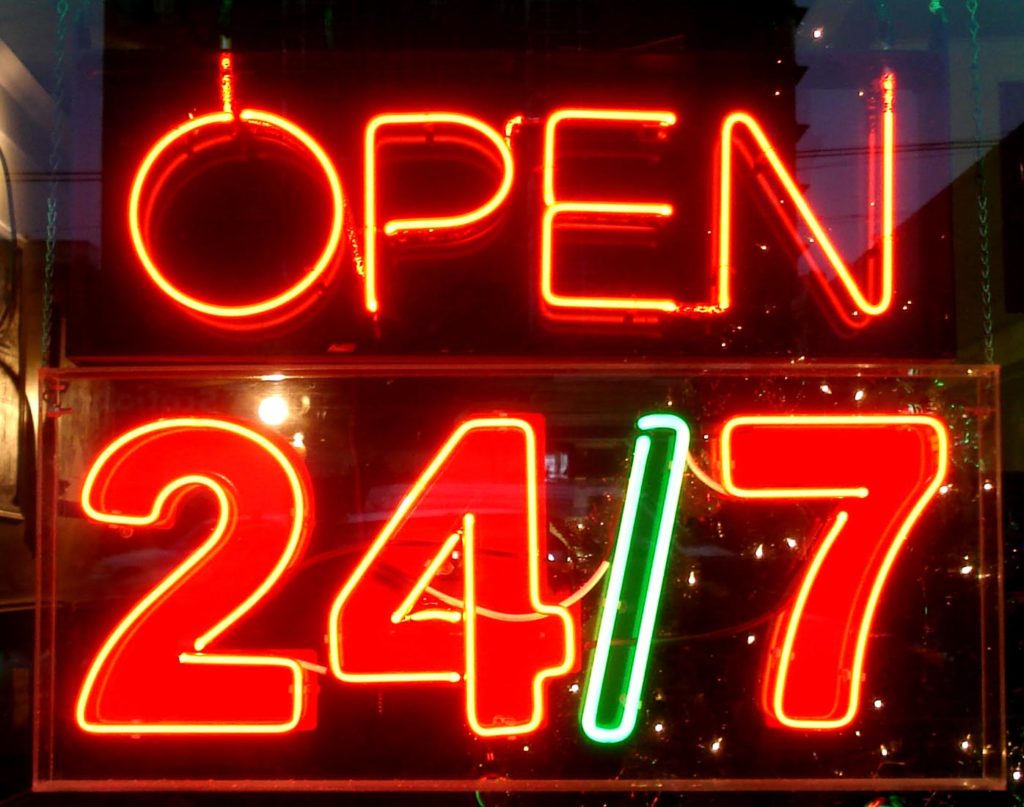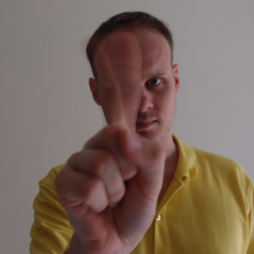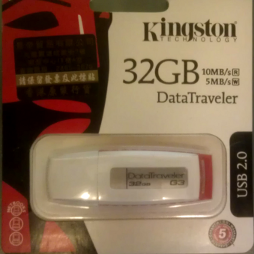This year Bitcoin celebrates its 10th anniversary. With bitcoin a new technology came into existence: the blockchain. Blockchains offer a powerful mechanism to achieve secure transactions that cannot be falsified, and this mechanism doesn’t need a central authority to verify or police it. Maybe the easiest way is to compare a blockchain with a chain of domino blocks. Each block logically follows the previous block. Only the domino player that has a matching block can append it to the chain. All players keep an eye on the board and a player who tries to append a block that doesn’t fit the end of the chain will have to skip turn for cheating. In the case of blockchain a block does not include dots, but instead a list of recent transactions of cryptographic assets.
» Read more…The 24/7 company

Sometimes it’s like a shop without a shopkeeper. You get to a company’s website, you are seriously interested in their products or services, but would like to know more before you sign-up or draw your credit card. Or you bought something that you are not completely satisfied with and return to the shop (the site) to find out that there is nobody there to talk to. Most sites have a contact form to send a message, but that it like posting a letter in a mailbox when you are standing right next to the guy you want to talk to. More and more sites offer a chat function to have immediate interaction.
» Read more…How to design your content strategy for the Chinese market
This article has previously been published in the magazine of the Dutch Chamber of Commerce in Hong Kong, issue 177 and has been modified slightly for the digital channel.
It’s a recurring question: how can we optimize our marketing communication for different geographical locations and target groups. We’ve already finished it for the western market, but how do we approach the East Asian market? For example, can we just translate our English website to Chinese? Well, No. » Read more…
Banks focus more on user experience

In the last 5 years the banking sector has changed significantly. We’ve previously needed banks for mortgages, to receive our salaries, pay our bills or get cash to do the groceries, etc.. The financial crisis made it clear that even the largest and most trustworthy banks could not guarantee to be here for good. At the same time, alternatives grew strongly in both numbers and maturity. Newcomers like PayPal, AliPay, ApplePay, Google Wallet, BitCoin and even Octopus provide new disruptive technologies that could in time overturn the whole banking landscape.
Traditional banks also face competition from so called neobanks. These banks without branches provide a (small) range of traditional banking services and distinguish themselves with transparent cost structures, low or no monthly fees, large ATM networks and easy to use and always up to date mobile apps. With their limited product portfolio they focus on service above product.
From selling products to managing user experience
How do banks respond to these trends? The way forward for the traditional banks is to focus more on service and improving their user experience, thereby reducing the need for consumers to seek alternatives. Some banks employ design talents to ‘pimp’ their online platforms. The design is indeed an important aspect of user experience. However, other aspects of functionality (how many banking tasks people can do with the platform) or usability (how fast, easy and pleasant the platform is to use and to understand) are equally or even more important.
Recent research in the UK found that mobile banking apps of five major UK banks, including HSBC, failed their user experience test. Even though some of the user-interfaces were visually attractive and user-friendly, they only provided functionality for a limited number of banking tasks. Consumers expect more. Traditional banks have the organization and infrastructure to provide a much wider range of services than neobanks or the new technologies. The opportunity banks have, is to provide access to all these services on their website and mobile platform in a user-friendly way that (re-)imbues trust.
One of the challenges being faced is security. Banks traditionally focus on security and compliance. And security measures, when overdone, are annoying to users. New payment technologies either provide inherent security or security issues are of limited consequence, for example because of limited transaction amounts. On the other hand, fingerprint scanners and front camera face recognition now enable banks to provide a great user experience while guaranteeing their customers a minimum required degree of security. This requires a drastic change of focus, though: away from proven technology like security devices.
Cultural aspects of user experience
Cultural and legal differences are also relevant. In Common Law countries agreeing with detailed terms and conditions is often required. In Western Europe consumer protection and the reasonableness and fairness principle are dominant (including the reasonableness that endless terms and conditions or fine print may not always be assumed read or agreed upon). This reflects in the way that apps may deal with transaction confirmations and it directly impacts the user experience.
Apart from this, cultural aspects cannot be ignored when optimizing user experience: a red colored user interface that seems cluttered to some will (on average) not be appreciated in the same way in Europe as it would in China. Basing new apps or websites on generic usability guidelines is therefore not a guarantee for the best user experience for the target group. Every good development process is iterative and includes incremental improvements based on testing with real users. The Rabobank for example has a dedicated user experience lab in The Netherlands where existing functionality and improvements are extensively tested.
User experience beyond the online platform
Managing the user experience does not only involve websites and mobile apps. A customer experiences the products of a company via all available channels. The travel distance, waiting line, employee expertise and tone of voice suddenly become relevant when customers wants to visit a branch office instead of use the app. Cost transparency, simplicity of terms and conditions and an option to circumvent the automated telephone answering system all contribute to a better user experience. Although banks face fierce competition from new technologies and neobanks, there are enough opportunities to out-compete them and leverage existing strengths, but it does require a paradigm shift.
(This article first appeared in the Dutch Chamber Magazine, publication of the Dutch Chamber in Hong Kong)
UX design is not UX
Have you ever installed an App on your mobile that didn’t provide you the experience you had hoped for? Of course you have. Not all Apps are as good. (Actually the more Apps a store has the lower the average quality). Why was the experience not good? Was the App hard to use, did it look ugly, or did it have annoying advertisements that popped up at undesired moments (as if they could ever popup at desired moments), etc?
All these User Experience aspects are part of the User Interface (UI). In the last couple of years there has been a trend to describe these aspects, and the activities involved in improving them, with the term User Experience Design or just UX. Unfortunately, this attention to UX has diluted the name of this interesting field of work.
» Read more…Coaching vs Correcting

Unfortunately, sometimes you have to say “No”
Now that I have the honor and pleasure of being a father, I have to admit, that becoming one has dramatically changed my life. One of the things that changed are the kind of things you talk about with friends. Now suddenly the main topic has become the baby: how old is he now, does he sleep during the night, how heavy is he, etc. And sometimes the future is discussed: which school will you choose (or have you chosen) or in which language(s) will you raise your son? With a Dutch father, Taiwanese mother and part Korean family in a country that speaks Cantonese and English, that is a difficult topic. Some time ago I talked to my cousin who has a son that is a few years older. His son is a naughty little guy, very typical for his age. Somehow we got to the topic of where correcting transforms into coaching. » Read more…
Why choice is bad
One of the great regular TEDTalks contributors, Barry Schwartz, held a lecture about why the amount of choice we have in our lives is a bad thing. I just found the lecture on Youtube and while the TEDTalk was already held in July 2005, I think it’s still valuable.
Why choice makes people miserable:
- Regret and anticipated regret
- Opportunity costs
- Escalation of expectations
- Self-blame
The best quote: “The secret to happiness is … low expectations.” (Barry Schwartz, 2005)
Watching this video should be life-changing for marketeers and will change the way they approach portfolio management and the choice (=responsibility) they give consumers: » Read more…
Moms doing the worst job in the world, with P&G
Proctor & Gamble rarely mess it up, when it comes down to marketing campaigns. But now they do seem to have. In their “Proud sponsors of Moms” campaign they have lowered themselves to one of the lower of the lowest, if it comes to parenthood. In the ad below they glorify the disgustingly pushy behavior of moms accepting nothing but the best from their children’s performance in sports. Those moms will stop at nothing: dragging their children out of bed to training in the early morning when the kinds clearly need their rest, showing only disappointment and no support when their son or daughter fails and only showing happiness when they (the parents) reach their goal: they have made their child win Gold in the Olympics.
Let’s think about it a bit further: Wouldn’t it be great if your child becomes an Olympic champion? Yes, of course. It would make me proud, as well. But while I’m proud of my son every day, the chances that he will become a Olympic champion, especially when I push him very hard, are exceptionally small. Is a ruined youth worth the effort? Is it my right to ruin my son’s youth? Is it the right thing to do towards a happy (adult) life for my son? There are enough specialists pointing out why we should be aware of pushing our children too hard, before it is too late » Read more…
When not telling the truth is allowed
I recently bought a 32 GB USB drive. Not for small files of course (it would be a bit big for small files), but for carrying with me some large Virtual Machine images. (For an explanation on what virtual machines are, see wikipedia, but it’s not important for the story.) I did not want to spend too much money, but I did want a reasonably fast one, since I would be copying huge files (around 10 GB each) onto it. The shop had really fast ones (with speeds specified to be 20 MB/s), that were also really expensive. In the end I decided to go for the cheaper, mid range, Kingston DataTraveler G3. As you can see on the picture of the packaging, it should be able to write with 5 MB/s, and read with 10 MB/s. Not that fast, but fast enough for what I wanted to spend. I took into account that “they all lie” about this kind of specs. Those speeds are the ones you only achieve under the most optimal circumstances, etc.
I was pleasantly surprised when I saw the speeds reported by Windows when I was copying my large files » Read more…
Why Apple is on its way to become the new Palm
I recently read an article, which stated that RIM was becoming the new Palm. That might be a fairly good observation: RIM (the maker of BlackBerry phones) isn’t doing well at all after all. However, there are more and perhaps more likely candidates for this title.
Palm was once a high tech company with revolutionary and business changing products. It’s handheld computers, ‘palmtops’ or ‘personal assistants’ seamlessly (this is an evolving term) integrated with business tools like Outlook for email, tasks and calendar. Palm launched the first successful app shop, where you could buy thousands of apps to extend your Palm’s functionality with both productivity tools and games. Although the Palm platform was strong » Read more…

